-
In the lead region (Z = 82) near the neutron mid-shell (N = 104), the shape coexistence of spherical, oblate, and prolate shapes is well established. A striking example of shape coexistence is 186Pb, where a triplet of low-lying
$ 0^+ $ states has been found [1, 2]. In odd-A 187Pb, three bands with different shapes have also been reported [3, 4]. In addition, different shapes have been observed in 188,189Po and 185,188,189,190Pb [5−10].Another interesting phenomenon in this region is the presence of high-K isomers. They are present in well-deformed nuclei and even in transitional nuclei with mass near 190 [11, 12]. High-K isomers arise from the breaking of one or more nucleon pairs to form multi-quasiparticle (multi-qp) configurations. The K-hindrance and other properties of these states depend strongly on the proton and neutron states involved [13]. In 178Hf, besides the remarkable 31-year
$ K^{\pi} $ =$ 16^{+} $ four-quasineutron isomer [14], a two-quasineutron$K ^{\pi} $ =$ 8^{-} $ isomer arises from the coupling between nucleons in high-j orbitals ($ \nu 9/2^+[624] \otimes \nu 7/2^-[514] $ ). Similar two-quasineutron isomers have been observed systematically in even-mass N = 106 isotones from 174Er to 188Pb [11, 15].Furthermore, in the N = 106 odd-mass isotones from 175Tm to 187Tl (except the 183Ir) [16−21], 3-qp high-K isomers, originating from the coupling between the odd proton and abovementioned
$K ^{\pi} $ =$ 8^{-} $ isomer in even-mass cores, have been identified.The
$ N = 106 $ nucleus, 185Au, was previously studied in decay and in-beam γ-ray spectroscopy [22, 23]. A ground-state quadrupole deformation of$ \beta_2 $ = 0.24 was determined in a laser spectroscopy experiment [24].In this paper, we report on the discovery of a new isomeric state in 185Au at an excitation energy of 1504.2(4) keV, with a half-life of
$ T_{1/2} = 630(80) $ ns, decaying to the (17/2−) level previously assigned to the$ \pi1h_{11/2} $ band [22]. The possible spin-parities of this isomer are tentatively assigned based on Weisskopf estimates. The possible configuration of this isomer is discussed within the framework of configuration-constrained potential energy surface (cc-PES) calculations [25]. -
The experiment was conducted at Argonne National Laboratory (ANL), and this study extends prior results reported in earlier experiments from the same experimental program, which included 187Pb, 188Bi, 188Po, 183Hg, and 187Tl [3, 6, 21, 26]. In the present study, the 185Au nucleus was produced in the 50Cr + 142Nd → 192Po* → 185Au + 3pα fusion-evaporation reaction. The 50Cr ions were accelerated to an energy of 255 MeV with a typical intensity of 7 pnA by the superconducting linear accelerator at ANL. The target material, enriched to 99.8% in 142NdF3, had a thickness of 700 μg/cm2. To minimize target heating, four target sectors were mounted on a rotating wheel, and the beam was wobbled horizontally by ±2.5 mm across the target using a magnetic steerer.
Evaporation residues (EVRs) were separated from the primary beam by the Argonne Gas-Filled Analyzer (AGFA) [27], which was filled with 0.65 mbar of helium gas. The flight time of EVRs in the AGFA separator was estimated to be several hundred nanoseconds (approximately 500 ns flight time for v = 0.02c EVRs). The energy loss and arrival time of the EVRs were measured by a parallel grid avalanche counter (PGAC). The EVRs were then implanted into a double-sided silicon strip detector (DSSD) located at the focal plane, which recorded the deposition energy of the recoil and subsequent charged particle decay.
The present study was conducted with the delayed γ correlation method, using the DSSD and X-array detector in the focal plane. The X-array detector setup consisted of four Clover HPGe detectors and was used to detect X rays and γ rays emitted from the EVRs [28]. The typical energy resolution for the X-array was approximately 4 keV (FWHM) for γ rays of approximately 300 keV.
-
The delayed γ-ray spectrum recorded by the X-array detectors within 2 µs after implantation in the DSSD, with the background in the time window of 2−4 µs subtracted, is shown in Fig. 1. Most of the prominent γ-ray peaks are from known isomers produced in other reaction channels, including the strong γ ray from microsecond isomers in 187Tl and 187,188Pb.

Figure 1. (color online) Main panel: γ-ray energy spectrum recorded by the X-array within a 2 μs window after EVR implantation in the DSSD. A background spectrum taken from the 2−4 μs after EVR implantation is subtracted. The three γ-rays highlighted in red were experimentally established as a cascade in 185Au [22]. Inset: Expanded view of prominent γ-ray peaks from 260 to 400 keV.
The 212-, 462-, and 527-keV γ rays shown in Fig. 1 were initially reported in the in-beam experiment by Larabee et al. [22] as a prompt 527-462-212 keV transition cascade. Considering that the transport time through AGFA is more than hundreds of nanoseconds, these transitions are considerably delayed, indicating the existence of an isomer de-exciting via this prompt cascade.
A previously unobserved 294.8(3)-keV transition was identified in the γ-gated spectra of 527-, 462-, and 212-keV γ transitions, as shown in Fig. 2(a)−(c). The spectrum gated on the 295-keV transition and summed spectrum gated on the four transitions are shown in Fig. 2(d) and (e), respectively. This 295-keV γ ray is attributed to the deexcitation of the new isomer in 185Au.
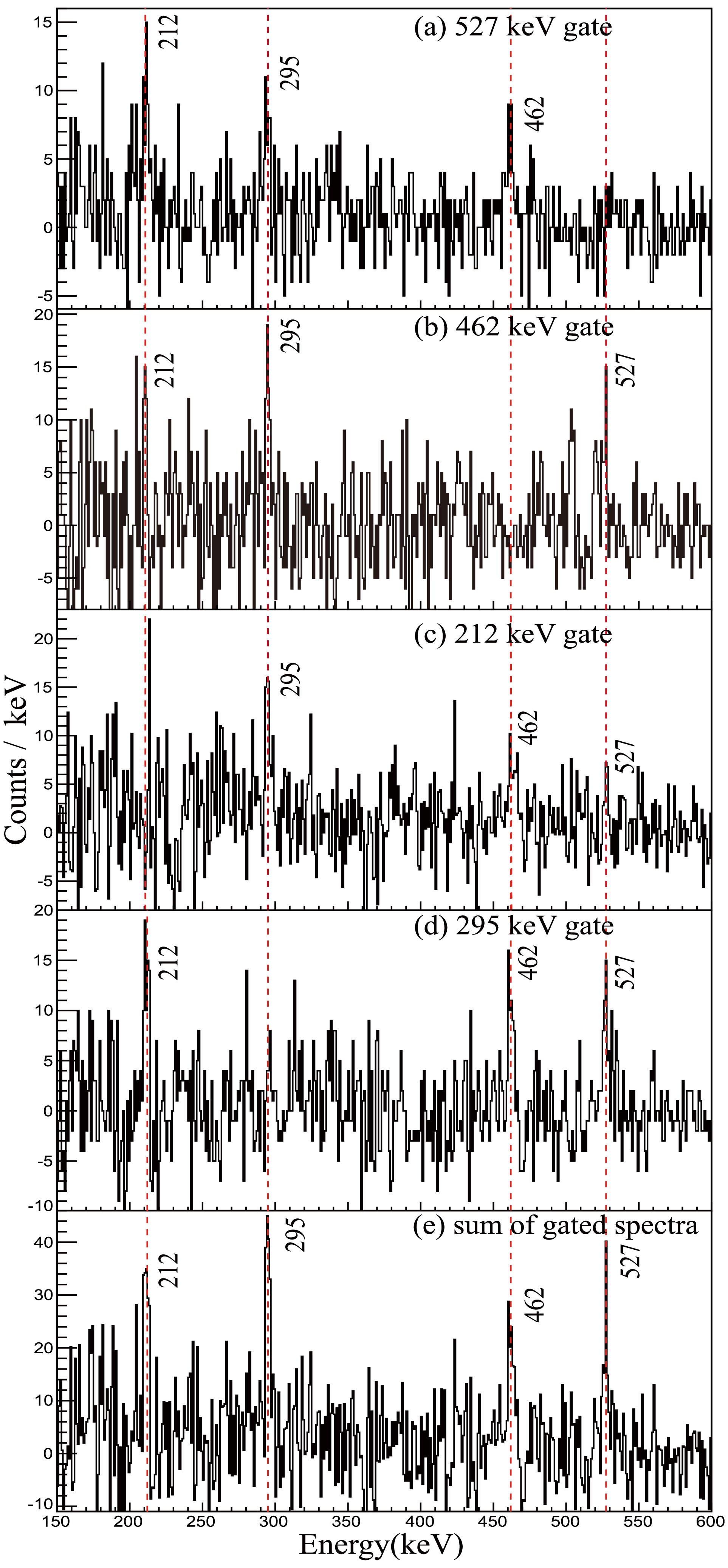
Figure 2. (color online) γ-ray energy spectrum gated on the 527-, 462-, 212-, and 295-keV transitions (a)−(d) and the sum of these spectra (e).
The time distribution of
$ \Delta T $ (EVR-γ (212 keV and 527 keV)) is shown in Fig. 3. Based on a least-squares fit of this time distribution, with an exponential function plus a constant background, the half-life of the isomer was determined to be 630(80) ns.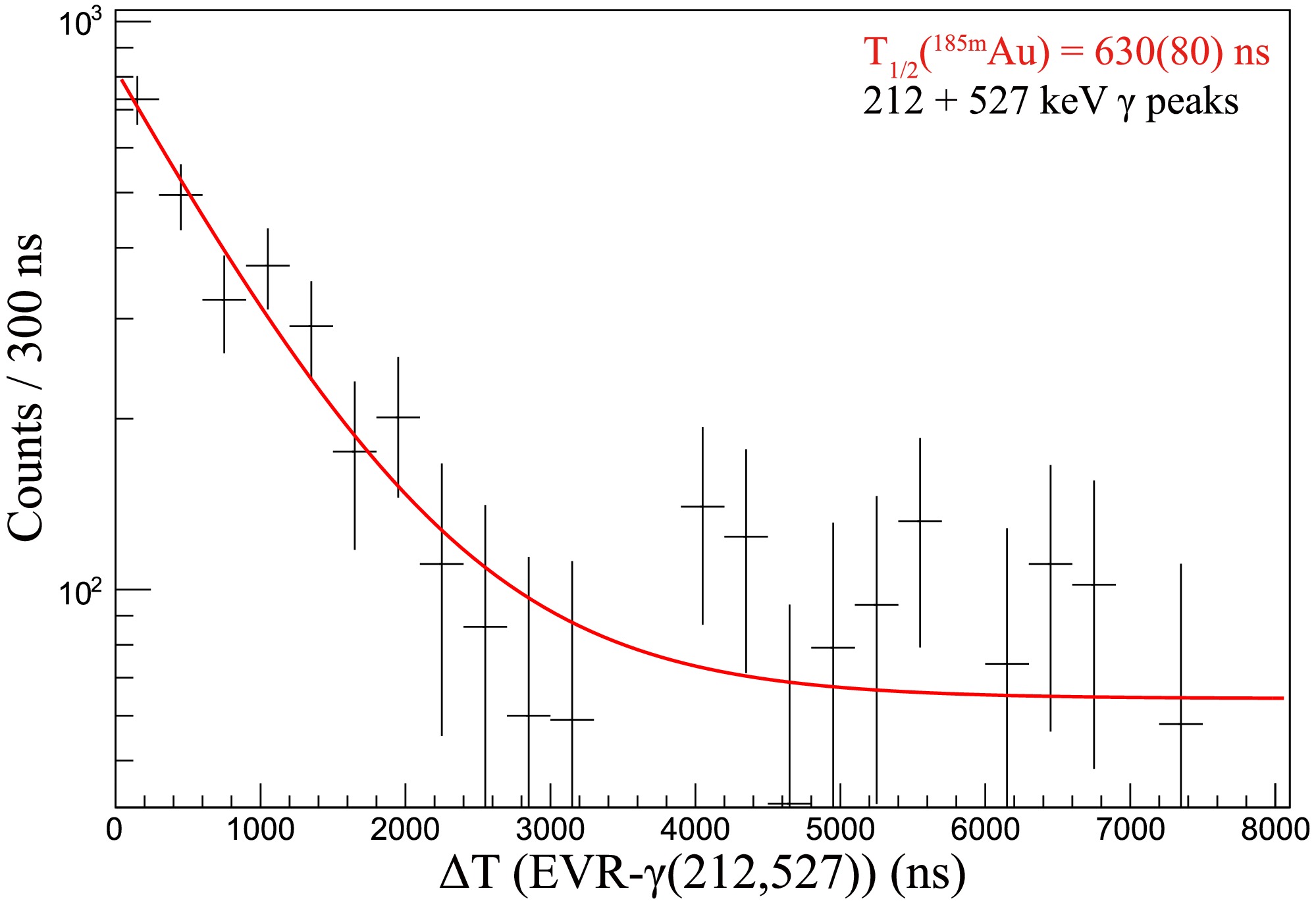
Figure 3. (color online) Time distribution of the summed 212 and 527 keV γ rays after EVR implantation, with a background subtraction made by gating on nearby Compton background. The data are fitted with an exponential function with a constant background.
Figure 4 illustrates the proposed decay scheme of the isomer along with a partial level scheme of 185Au, and it shows that the new 1504.2(4)-keV isomer decays to the 1209.4(3)-keV (17/2−) level. The spin and parity assignments for established levels were adopted from previous studies [22, 23], while the corresponding energy values were derived from the latest ENDF Library evaluations of 185Au [29].
No decay to other low-lying levels from this isomer was observed after a thorough analysis of the singles and coincidence spectra. We attempted to perform an intensity balance analysis of the 295-527-462-212 keV γ-ray cascade in the recoil-delayed γ-ray spectrum Fig. 1. However, as shown in the inset of Fig. 1, there is only a slight indication of a peak at 295 keV; hence, no definitive conclusions can be drawn on its multipolarity.
-
The Weisskopf single-particle transition probabilities for possible multipolarities (E1, M1, E2, M2, and E3) of the 295-keV γ-ray, corrected for internal conversion, are presented in Table 1. The E3 and higher multipolarities can be excluded based on the recommended upper limits [32]. The possible multipolarities constrain the spin of the 1504 keV isomer, decaying to (17/2−), to a range from 13/2 to 21/2. The Weisskopf hindrance factors (Fw, which is the reciprocal of transition probability) of the E1, M1, and E2 multipolarities are large, indicating significant hindrance.
Multipolarity assumed Weisskopf half-life estimates (s) Transition probability (W.u) E1 8.13(3) $ \times 10^{-15} $ 

1.3(2) $ \times 10^{-4} $ a

M1 8.59(3) $ \times 10^{-13} $ 

1.4(2) $ \times 10^{-6} $ 

E2 4.06(2) $ \times 10^{-9} $ 

6.5(8) $ \times 10^{-3} $ 

M2 4.29(2) $ \times 10^{-7} $ 

6.9(9) $ \times 10^{-1} $ 

E3 3.08(2) $ \times 10^{-3} $ 

4.9(7) $ \times 10^{3} $ 

a The transition probability of K-allowed E1 transitions is multiplied by $ 10^4 $ , as suggested in Refs. [30, 31].

Table 1. Weisskopf estimates of single-particle transition probabilities for different multipolarities of the 295-keV γ ray.
To assign the possible configuration to this new isomer in 185Au, we performed cc-PES calculations [25] based on the non-axial deformed Woods-Saxon (WS) potential [33] with universal parameters [34]. The total energy is composed of a macroscopic part with the standard liquid-drop energy [35]. To avoid possible pairing collapse in multi-qp states, the approximate particle-number conservation uses the Lipkin-Nogami (LN) method [36]. For a multi-qp state, the microscopic energy incorporates the contribution from the unpaired particles that occupy the single-particle orbits associated with the given configuration. The blocking effects from the unpaired nucleons are considered by removing the singly occupied orbitals from the LN calculation. The cc-PES calculations were performed in the lattice of deformation space
$ (\beta_2, \beta_4, \gamma) $ . The resultant PESs can self-consistently provide information on the deformation, excitation energy, and pairing interaction properties of multi-qp states. The calculations successfully reproduced the experimental results for the 3-qp configurations in N = 106 odd-A isotones, with excitation energy deviations ranging between 1 and 174 keV (181Re 21/2− isomeric state [19] and 175Tm 23/2 + isomeric state [16]). Details of the calculations will be presented in a forthcoming paper [37].In previous experimental studies, the ground-state band (C) was proposed to originate from the strongly mixed
$ \pi3/2^-[532] $ and$ \pi1/2^-[541] $ configuration [38, 39], while Band (B) was assigned to an$ h_{11/2} $ single-quasiproton configuration [22]. PES calculations for all possible low-lying proton configurations near the Fermi surface were also performed, and the results for the$ 3/2^-[532] $ and$ 1/2^-[550] $ configurations are shown in Fig. 5. The results for the$ 3/2^-[532] $ configuration reproduce the$ \beta_2 = 0.24 $ ground-state deformation from the laser spectroscopy measurements [40]. Band (B) corresponds to the$ 1/2^-[550] $ orbital, as shown in Fig. 5 (right). Notably, the PES calculations show remarkable triaxial deformations for the two low-lying configurations, similar to those observed in calculations for neighboring 183,187Au [41, 42].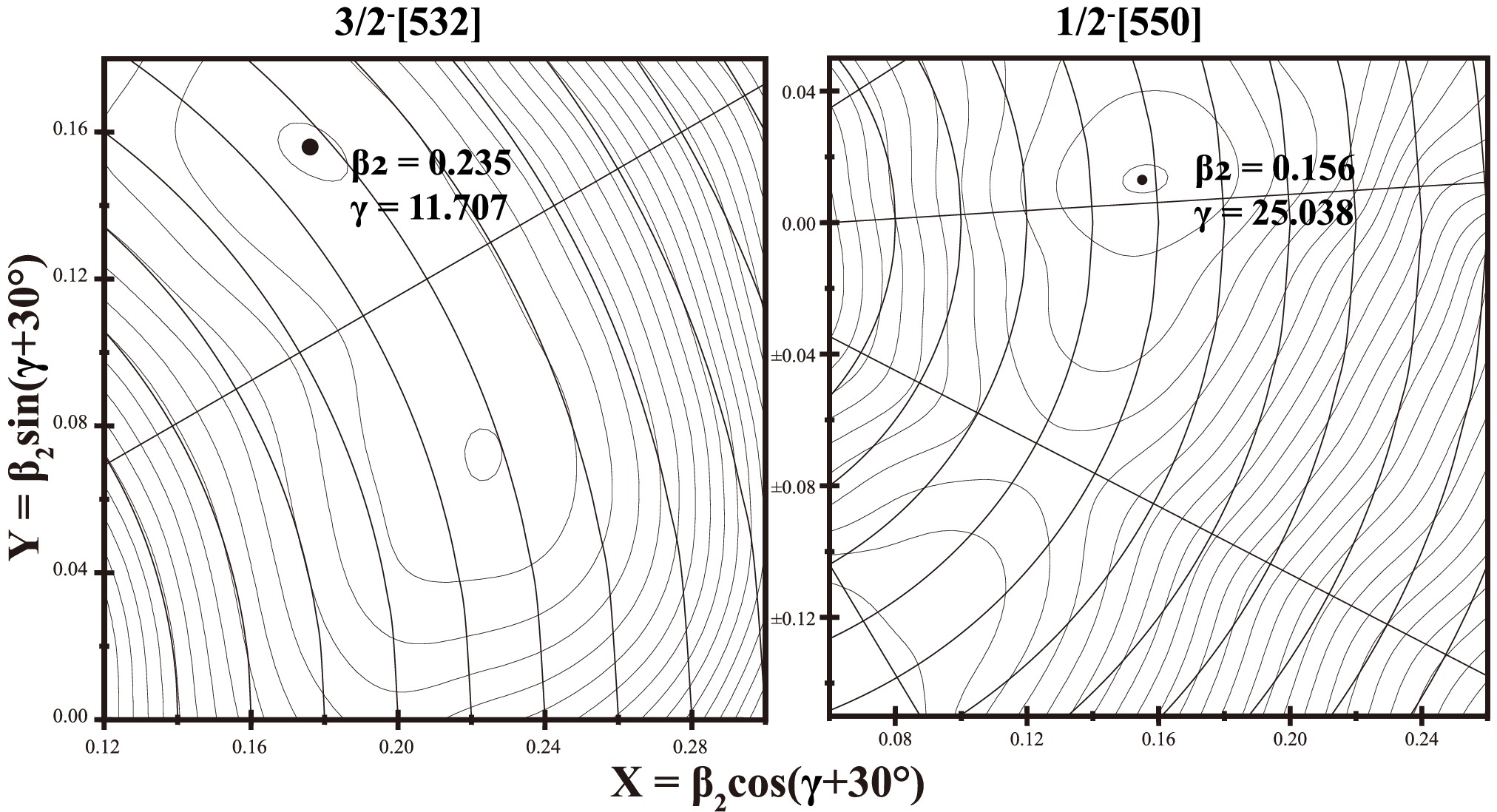
Figure 5. PES of low-lying proton states in 185Au: (left)
$ h_{9/2} $ ground-state band and (right)$ h_{11/2} $ band. In calculations using cc-PES calculations, the minima are indicated by black circles and labeled with their deformation parameters.The calculated excitation energies and deformations for possible 3-qp configurations in 185mAu are presented in Table 2. These high-K states are all predicted to lie close to the measured excitation energy of 1504 keV. However, it should be mentioned that the residual interactions between unpaired nucleons are not accounted for in the present calculations. These residual interactions can lead to energy shifts of up to a few hundred keV, depending on the relative orientation of intrinsic spins of the nucleons involved [43−45]. Therefore, in the context of the excitation energy and decay patterns, we are unable to make a firm assignment for the configuration of the observed isomer from the calculated 3-qp configurations. The calculated results incorporating the neutron configuration
$ \nu 9/2^+[624] \otimes \nu 7/2^-[514] $ are consistent with systematics of 3-qp configurations in odd-mass nuclei with N = 106. However, further experimental data are required to unambiguously assign the spin-parity and configuration of the 1504 keV isomer.$ K^{\pi} $ 

Configuration Energy/keV $ \beta_2 $ 

$ \beta_4 $ 

γ 17/2− $ \pi 1/2^- [541] \otimes \nu 9/2^- [505] \otimes \nu7/2^- [503] $ 

1041 0.153 -0.010 22.907 21/2+ $ \pi 11/2^- [505] \otimes \nu 9/2^- [624] \otimes \nu1/2^- [521] $ 

1289 0.168 -0.041 -25.477 17/2+ $ \pi 1/2^- [541] \otimes \nu 9/2^+ [624] \otimes \nu7/2^- [514] $ 

1444 0.230 -0.033 1.036 19/2+ $ \pi 3/2^- [532] \otimes \nu 9/2^+ [624] \otimes \nu7/2^- [514] $ 

1458 0.246 -0.031 1.144 17/2+ $ \pi 1/2^- [541] \otimes \nu 9/2^+ [624] \otimes \nu7/2^- [503] $ 

1582 0.165 -0.037 25.680 17/2+ $ \pi 1/2^- [541] \otimes \nu 9/2^- [505] \otimes \nu7/2^+ [633] $ 

1632 0.159 -0.024 24.605 17/2+ $ \pi 1/2^- [530] \otimes \nu 9/2^+ [624] \otimes \nu7/2^- [514] $ 

1633 0.252 -0.030 0.210 13/2+ $ \pi 3/2^- [532] \otimes \nu 9/2^+ [624] \otimes \nu1/2^- [521] $ 

1652 0.223 -0.038 20.593 15/2+ $ \pi 1/2^- [541] \otimes \nu 7/2^+ [633] \otimes \nu7/2^- [503] $ 

1667 0.169 -0.032 25.437 19/2− $ \pi 3/2^- [532] \otimes \nu 9/2^+ [624] \otimes \nu7/2^+ [633] $ 

1733 0.227 -0.037 -14.634 21/2− $ \pi 5/2^+ [402] \otimes \nu 9/2^+ [624] \otimes \nu7/2^- [514] $ 

1757 0.266 -0.028 0.299 17/2− $ \pi 1/2^- [550] \otimes \nu 9/2^+ [624] \otimes \nu7/2^+ [633] $ 

1778 0.153 -0.026 -26.763 19/2+ $ \pi 3/2^- [532] \otimes \nu 9/2^+ [624] \otimes \nu7/2^- [503] $ 

1875 0.200 -0.044 -26.624 15/2− $ \pi 1/2^- [541] \otimes \nu 7/2^- [503] \otimes \nu7/2^- [514] $ 

1969 0.214 -0.031 21.749 Table 2. Possible 3-qp configurations for the isomeric states in 185Au. Excitation energies and deformation parameters were calculated using cc-PES calculations.
-
A new isomer at 1504 keV in 185Au was identified through its deexcitation to a previously known level, by a 295-keV transition coinciding with the known 212-462-527 keV cascade. Possible multipolarities of E1, M1, E2, and M2 have been proposed for this transition in comparison with predictions from Weisskopf estimates. By using the cc-PES calculations, which describe the systematics of known three-quasiparticle isomers in odd-mass N = 106 isotones well [37], possible spin-parity and configuration candidates for the new isomer at 1504 keV in 185Au were provided.
-
We thank the Target Labor team of GSI for preparing the targets for the experiment.
Observation of a new isomer in 185Au
- Received Date: 2025-03-14
- Available Online: 2025-08-15
Abstract: Delayed γ-ray spectroscopy of 185Au was studied at the Argonne Gas-Filled Analyzer. A new isomer at an excitation energy of 1504.2(4) keV with a half-life of 630(80) ns was identified via γ-γ coincidence analysis, decaying via a 294.8(3) keV transition. Based on Weisskopf estimates, the multipolarity of the 295 keV transition is assigned to be E1, M1, E2, or M2. Possible configurations for this new isomer are discussed based on configuration-constrained potential energy surface calculations.





 Abstract
Abstract HTML
HTML Reference
Reference Related
Related PDF
PDF

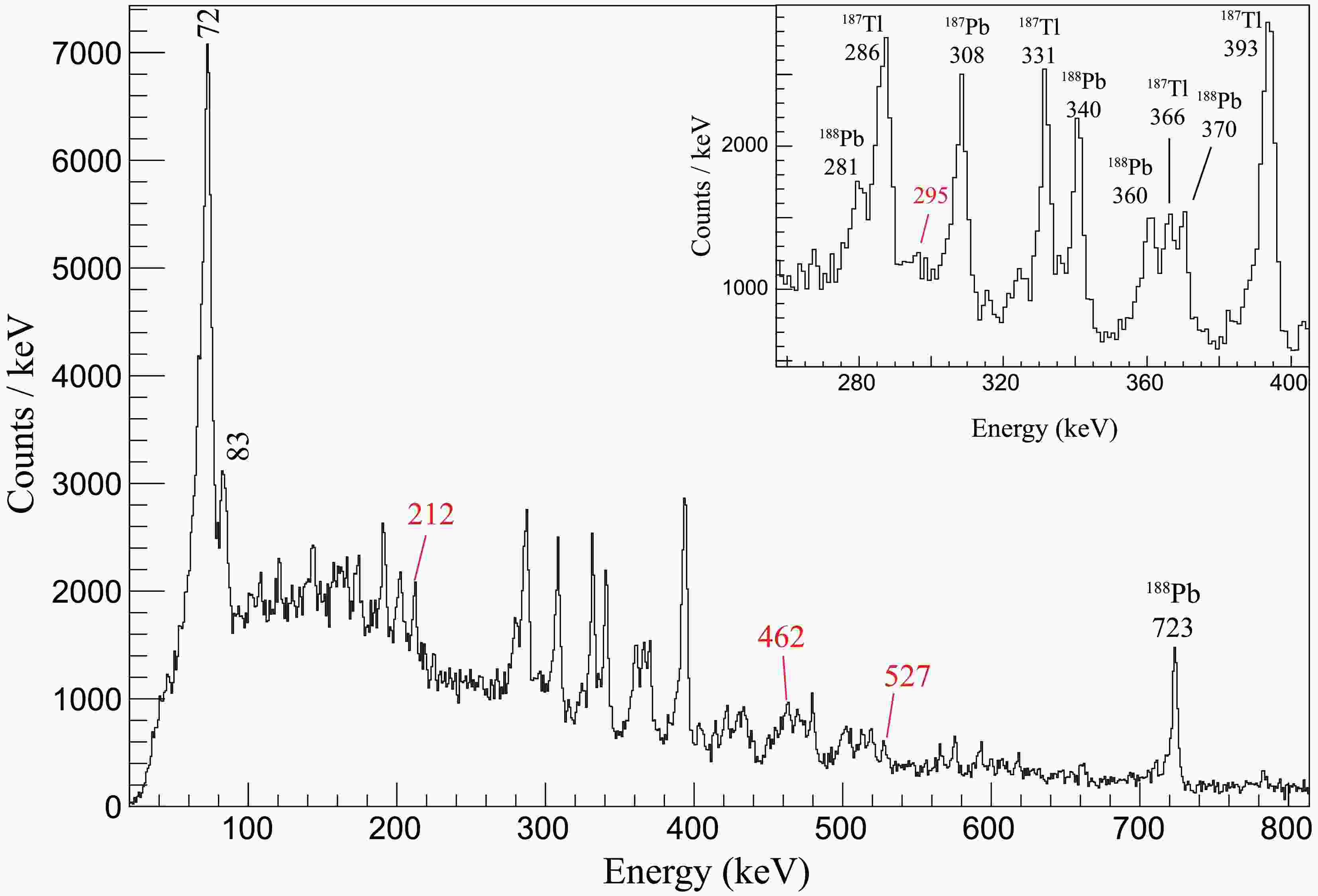










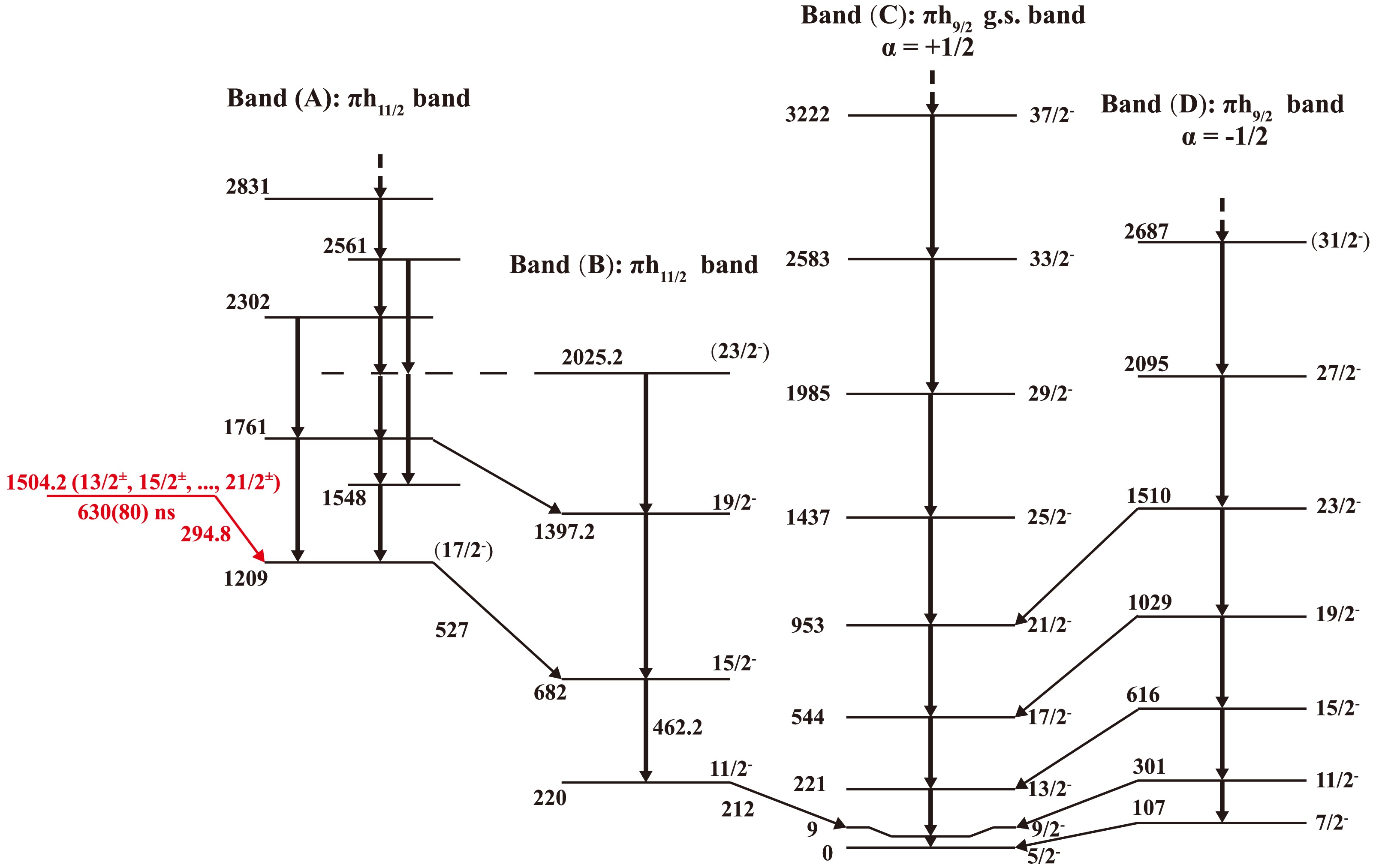



 DownLoad:
DownLoad: